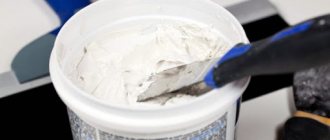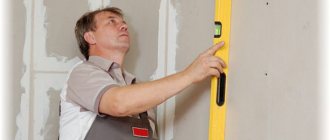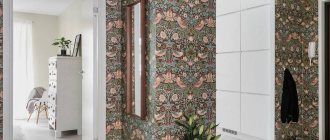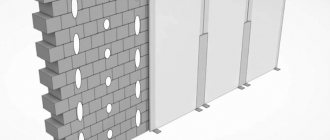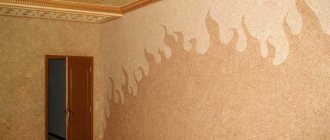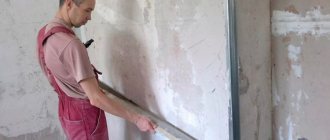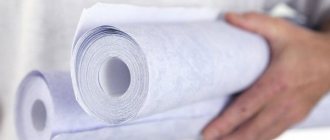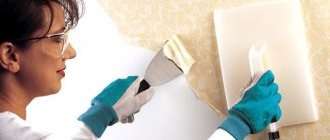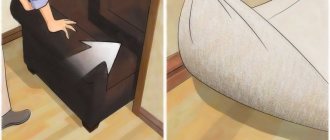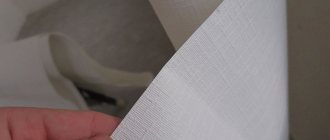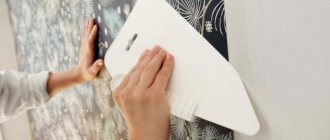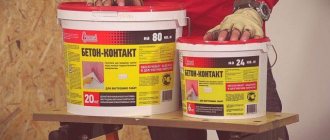Among the variety of finishing materials for the walls of residential premises, wallpaper is given clear preference. Vinyl, non-woven, paper and other original varieties will add harmony and comfort to the room if the canvases are glued to a carefully leveled surface. A special solution can make the wall uniform and smooth. Finishing plaster is an intermediate composition, which is the basic basis for further decorative finishing. Knowledge of the types of mixtures and the intricacies of process technology will help you plaster uneven surfaces with your own hands.
Selecting an alignment method
You can level the walls with plaster, putty and drywall. The choice of method is not so much a matter of the personal wishes of the home owners as the need to give these structures all the required characteristics. Namely, heat and sound insulation properties, being in a vertical plane, strength and smoothness of the surface. If there is a need for hidden wiring and other communications, this must also be taken into account.
- First of all, the strength and integrity of the walls, especially the external ones bordering the street, are assessed.
The presence of through seams, cracks and other serious defects will require their elimination before leveling the walls for wallpaper. Moreover, such walls need to be repaired not only inside, but also outside, in order to protect them from atmospheric moisture, blowing and other negative influences. Without this, dampness and fungus will settle in the house, it will be cold, and no finishing will stick to the walls.
Such defects require serious repairs Source vop.ru
- The second factor influencing the choice of leveling method is the curvature of the walls: the deviation of their plane from the vertical, the presence of noticeable depressions and bumps, and peeling areas.
The degree of curvature is determined using a plumb line and any building level. If the deviation from the level and the depth of the unevenness is no more than 10-15 mm, you can get by with leveling putty on the walls. If they are larger, you must use plaster or drywall.
Checking the vertical level using a plumb line and tape measure Source legkovmeste.ru
Advice! It is better to assess the condition and curvature of the walls after removing the old coating, under which cracks, peeling plaster, wet areas and areas affected by fungus may be found.
- Also, the need to insulate them and lay communications influences how to line the walls with wallpaper.
You can insulate the walls by installing a heat-insulating layer and plastering it or covering it with sheets of plasterboard. It is easiest to lay pipes or electrical wires under them. But if the walls are fairly even, communications can be laid in grooves or specially made decorative boxes, so as not to reduce the area of the room with thick-layer finishing.
Even heating pipes can be hidden under a layer of plaster Source oboiman.ru
Plastering
To apply the solution you will need a grout, a trowel, a falcon, and a rule (aluminum straight tool). The prepared solution is scooped out of the container and applied to the falcon, it is held in the left hand. Throw the composition onto the wall with a trowel; movements should be sharp.
The stronger the throw, the better the plaster will stick to the base. The solution is poured from below and slowly moved to the ceiling. When the entire treated area is covered, move on to the next one, leaving the mixture in such lumps for 20–30 minutes. Then, as a rule, the solution is leveled along the wall, focusing on the beacons. The tool is placed on them and moved upward to remove excess mixture.
After the wall is completely processed, the beacons are removed from it and the remaining problem areas are treated with plaster. Leave the surface in this form for 40–60 minutes. The solution sets and is then rubbed to create a smoother surface. Any abrasive material is suitable for this. When using it, do not press on the device. With its help, all minor shortcomings that a person made at previous stages are eliminated.
If everything is processed correctly and the surface is beyond doubt, then wallpaper is glued onto it. If there are any defects, the walls are puttyed. After this, the primer is applied again and the wallpaper is pasted. However, if you follow the recommendations and the described rules, putty becomes an optional step that can be skipped.
Leveling using building mixtures
Regardless of what is chosen for the rough finishing of the walls - putty or plaster - leveling should begin with their preparation.
Preparatory stage
After removing old wallpaper or paint from the walls, you need to carefully evaluate the surface. If the previous repair was carried out efficiently and the coating was removed carefully, it may not require leveling or any other preparation other than priming the walls to strengthen the top layer and its better adhesion to the adhesive composition.
In other cases, before leveling the walls for wallpaper with your own hands, you need to do the following:
- clean the surface to a solid base from cracked and crumbling rough coating;
Advice! To find such areas, tap the wall with a hammer.
- remove all protruding obstacles - lumps, pebbles, mortar deposits in masonry joints, etc.;
Depending on the scale and size of the protrusions, use a spatula, sandpaper or grinder with an abrasive wheel Source arga-mag.com
See also: Catalog of companies that specialize in home reconstruction and repair work
- treat the surface with a primer suitable in composition to the wall material;
- if the walls are relatively smooth, but there are rare depressions and cracks, seal them with a repair mixture, let them dry and sand them.
Before puttying, it is allowed to seal defects with a repair solution Source megastroy.ru
Plaster
This leveling method is the most expensive and time-consuming, but also the most reliable. By applying plaster in several layers, you can correct any unevenness and bring the surface of the walls into line with the level.
First, choose the type of plaster - cement or gypsum.
- The cement composition is not afraid of moisture, is easy to apply and has a low cost. But it takes a long time to dry, and when dry it shrinks with the appearance of cracks, so it is applied in layers no more than 3 cm thick or reinforced with reinforcing mesh.
- Gypsum plaster is more expensive, it dries quickly, which makes application more difficult, but it does not shrink or crack. It is afraid of moisture, so it is not recommended for wet rooms.
It is impossible to say which plaster is better for leveling walls under wallpaper - each has its own advantages. But if a surface finished with gypsum can simply be sanded before decorating, then a cement surface will also need to be puttied to make it smooth.
Plaster mixtures Knauf Source alfacorp-shipping.com
For reference! Often, homemade cement-sand mortar is applied to brick or block walls as the first leveling layer, which reduces the cost of repairs.
If the depth of defects or deviations from the level require the installation of a thick plaster layer, then after priming, a special plaster mesh is fixed to the walls, which will serve as a supporting frame.
Further along the level, beacons are placed in increments smaller than the length of the rule for leveling the plaster. The mixture is thrown onto the wall between adjacent beacons and zigzag movements from bottom to top are leveled by a rule that rests on these beacons. After finishing the work, they are carefully removed from the fresh plaster, and the grooves formed in their place are immediately sealed with a working solution.
Required Tools
Depending on the method chosen, different tools will be used. For plasterboard cladding you need:
- rule for leveling putty;
- plumb line and level to determine the geometry of the structure;
- cord and tape measure for taking measurements;
- knife for cutting drywall;
- rubber mallet or mallet;
- glue container;
- construction mixer for diluting the mixture;
- jigsaw for cutting material;
- perforator;
- screwdriver
Before you start work, prepare the necessary tools.
For putty you will need:
- spatulas
- level
- rule
- cord (twine).
High-quality plastering is performed using the following tools:
- level and rule for leveling surfaces;
- trowel for “delivering” glue to the corners;
- spatulas of various sizes;
- trowel for grouting plaster;
- containers for mixing the solution;
- drill with attachment or mixer;
- tape measure for taking measurements.
To prepare the walls for work, you will need to use scrapers, metal brushes, and sandpaper.
you will need to use scrapers, wire brushes, sandpaper
Leveling with plasterboard
There are two technologies for how to independently level walls for wallpaper using plasterboard sheets.
- Gluing.
It is used on relatively flat walls with slight curvature. It is possible to pre-fill large depressions with plaster. Glue is poured onto the back side of the sheet in small piles, then pressed against the wall and leveled. The glue squeezed out at the joints is removed with a spatula. For additional fixation, use dowels in several places.
Gluing drywall to the wall Source lifehacker.ru
How to choose the right materials?
It’s not news to anyone that before gluing wallpaper, the walls need to be not only plastered, but also puttied. Such actions help you create the most even base with your own hands and ensure high-quality fixation of the wallpaper to the wall.
Plastering the wall
Of course, if experience and knowledge allows you, wallpaper can be glued directly to the plaster. The service life of such adhesive will be an order of magnitude shorter, but by performing the work adhering to certain rules, the number of risks can be reduced.
When purchasing all the necessary materials, you need to pay attention to the following nuances:
- You can immediately glue only medium-density wallpaper onto the plaster, because due to low adhesion, the strip can fall off under its own weight, and all the unevenness of the wall will be visible from under the thin roll;
- select the right leveling solutions (it is better to choose materials that contain gypsum binders, in this way you will achieve high-quality wall covering and effective penetration of glue);
- Do not under any circumstances use plaster with coarse sand fractions under wallpaper (coarse-grained compositions reduce the level of wallpaper pasting by 35-45%, and fine-grained compositions, although they are more expensive, can significantly reduce the cost of putty).
Video description
How to install gypsum boards on a frame, see this video:
The second method of leveling walls with plasterboard reduces the area of the room due to the indentation from the base surface. But it will allow you not to dismantle the old finish, lay any communications behind the cladding and install a thermal insulation layer.
It is important! When installing gypsum boards in any way, you need to mark out sockets, switches, meters and other equipment on sheets in advance.
After completing the installation, it is mandatory to putty the joints between the sheets and cover the recesses above the screw heads. The dried putty is sanded with fine sandpaper.
The result is a perfectly smooth and even base on which you can glue wallpaper. But first you need to make sure that they have sufficient density and are not see-through. If the wallpaper is thin and light, stripes of putty on the seams can stand out on the freshly wallpapered wall and spoil the look.
These spots and stripes can show through the wallpaper Source roomble.com
Experts advise in any case to cover the drywall with a thin layer of finishing putty, which will even out the color of the surface, protect the cardboard layer from being soaked with wallpaper glue and allow you to easily dismantle the outdated decorative coating when the time comes for the next repair.
But if you have thick non-woven wallpaper, simply priming the walls is enough. When you remove such wallpaper during the next repair, its bottom layer will remain on the surface.
What wallpaper lines the walls
In addition to various materials, wallpaper itself can also be used as a wall leveler, but you need to choose it very carefully, because not every type is suitable for leveling:
- paper wallpaper;
- vinyl of various options;
- liquid;
- textile; velor;
- cork and others.
Using liquid wallpaper, you can level the wall.
To level the walls, it is most effective to use foam wallpaper, made in different colors and various patterns and characterized by sufficient density.
The same role is played by non-woven wallpaper, which, due to its texture, reliably hides the curvature of the walls.
Advice. When choosing wallpaper for uneven walls, it is better to abandon clear patterns, which will only sharpen attention to the defect.
Briefly about the main thing
When choosing the best way to level the walls for wallpaper, you must first determine their curvature and the general condition of the surface. If it is strong, stable and with slight deviations from the level, it is best to use putty. Curved walls with serious defects, as well as those in need of insulation and sound insulation, are leveled with plaster or plasterboard sheets. The plaster is applied not in one thick layer, but in several, gradually bringing the surface to the desired plane. Drywall can be glued to walls or attached to a pre-assembled frame.
Ratings 0
Cement mortar
Based on cement, base mixtures are created that can be used to level out significant defects. They can be applied in separate layers up to 5 cm thick or more, but this is only possible if the finishing is carried out in stages. Unlike gypsum analogues, cement mixtures are not afraid of dampness, which allows them to be used in kitchens, bathrooms, as well as in basements and other wet rooms.
A significant drawback of this method is the inadmissibility of sticking wallpaper directly onto a surface treated with a base solution. Due to the fact that the filler in it is dispersion sand, the surface is slightly rough.
For final leveling, the walls will need to be finished using putty.
Most often, cement mortar is used for plastering surfaces with significant unevenness (with mesh reinforcement mesh, for example), or when processing brickwork.
